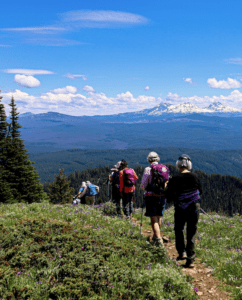The idea of a lobby meeting with an elected official can be intimidating, but remember, your legislators work for you! Meetings can be in-person or by video, and are often with a staff person who is a great liaison between you and your representative.
What is lobbying?
Lobbying is defined as attempting to influence an elected official’s position on an issue or piece of legislation. There are some limitations to what 501(c)(3) non-profit organizations are allowed to do in this regard, but any person can meet with an elected official or their representative to advocate for a position on an issue or bill. While “lobbying” often gets a bad rap, it’s really all about constituents participating in our democracy by talking to our elected representatives.
Why is it important?
We live in a representative democracy. We need to take advantage of the opportunities afforded constituents to influence our representatives. Our elected officials represent us and one key way you can make a difference for our public lands, vulnerable wildlife, and our climate is by meeting face to face with them to talk about the issues that matter most to you. Your voice matters!
How does one get started?
It can be confusing or even intimidating to figure out where to start if you want to meet with your elected representative. This guide will walk you through the process of preparing for and executing a meeting with your legislator. You can always contact one of Oregon Wild’s staff to help you too!
Setting up a meeting
A few options:
- Sign up for an organized lobby day with an organization you trust and that works on issues you care about. Usually, your meetings are scheduled for you and you’ll be assigned to work with other constituents and given instructions.
- Call or e-mail the local office of the representative you want to meet with to request a meeting on your own.
- Let the office know what your topic is so you set the meeting with the right staffer
- Consider going with an ally or someone with a different background than you, to send your message in a unique way.
What to expect at a lobby visit
- You’ll probably meet with a staff person, not the elected official. It’s all good: They are an extension of the legislator!
- You should expect to have just 10-15 minutes or so of their time (unless another expectation is discussed in advance).
- You might not get an answer to your “ask”.
- Be prepared for chaos – plans can change at the last minute!
Preparing for the meeting
- Know who you are meeting with – it might be a staffer.
- Know a few details about the bill or issue, including the bill number and what the bill says if possible.
- Know the legislator’s history on the issue
- Understand what role the legislator can/does play on the issue.
- Define your “ask”.
- This is a yes/no question that sums up your visit. For example: Can I count on you to vote YES on Bill X? Will Senator Y vote NO on Bill Z?
- Develop a fallback “ask”
- This could be something with less commitment than voting a certain way, like: What do you need to help you get to a “yes” vote on this bill?
- Prepare something to leave behind – a handout with relevant resources, photos, facts, and contact info.
At the meeting: General guidelines
- Dress for success
- Generally, it is best to dress professionally for a meeting. If you are going as part of a group or representing a particular interest, you might consider coordinating a “look” with a group shirt or color.
- Arrive a few minutes early, but be prepared to wait.
- Be polite, professional, and organized.
- Maintain a good attitude, and be respectful of the legislator’s viewpoint and time.
- Approach the meeting as an opportunity to inform and to have a conversation.
- Present your view and have an “ask” and a fallback prepared.
- Know & respect time limitations
- Personal stories are more likely to engage the staffer or official than reciting stats.
- Be direct and succinct.
At the meeting: What to say
- Identify yourself
- Introduce yourself with your name and where you live/are from.
- If relevant, say what your profession, expertise, or interest is.
- If you are there on behalf of a special interest group, state the name of the organization or group, briefly describe the group’s mission, and state how many members it has.
- Make a connection
- If you know you have something in common with the legislator (an activity, a place, a person, etc) use it in your introduction.
- Stand out by presenting your message in a memorable way – consider photos or other “props”.
- Know and mention something about your legislator’s history on your issue.
- Give thanks
- Even if you don’t agree with the legislator on much, thank them for something they have done or said that you do agree with. Acknowledge their efforts on the issue. For example: Thank you for your past support of protecting Wilderness in Oregon.
- Balance facts and experience
- Your issue and “ask” should be well-informed by facts, but it’s also important to speak from experience – it’s what makes your visit unique!
- You do not need to be an expert to talk to your legislator!
- Talk about how the policy, law, or issue in question affects you and people like you.
- Use your own words and describe personal experiences without being melodramatic.
- Back up your information with citations to reliable sources if possible.
- Consider having a copy or link to your sources to provide to decision makers.
- Make your ask
- Give a clear and concise description of your position on your issue or a specific bill, including the “why”.
- Example: “I oppose House Bill 3515 because…” or “I support additional protections for Wilderness, and here’s why…”
- State exactly what you would like the legislator to do.
- Example: “I would like you to support Senate Bill 2890.”
- Ask for support for your position or for a specific action.
- Example: “Will you introduce legislation to protect Wilderness this session?” or “Can I count on you to vote against House Bill 2614?”
- Offer a proposed solution or alternative if you can.
- Example: “I believe the science shows that communities can be made safer from fire by focusing on reducing fuels closest to homes, rather than in the backcountry. You should support X Bill, which does this, rather than Y Bill, which does not.”
- Have a fallback “ask” that might be more “doable” or immediate for the legislator.
- Example: “Can I send you more information to back up my position before you cast your vote?”
- Give a clear and concise description of your position on your issue or a specific bill, including the “why”.
- Wrap things up
- Thank them for their time
- Leave a small handout summarizing your position and ask, with your contact info and other resources.
Follow up
- Write up your notes and share with relevant allies
- Sending a written thank you (email is easiest) is a way to remind the legislator of who you are and what your message was.
- Consider a repeat visit – advocacy takes persistence!


